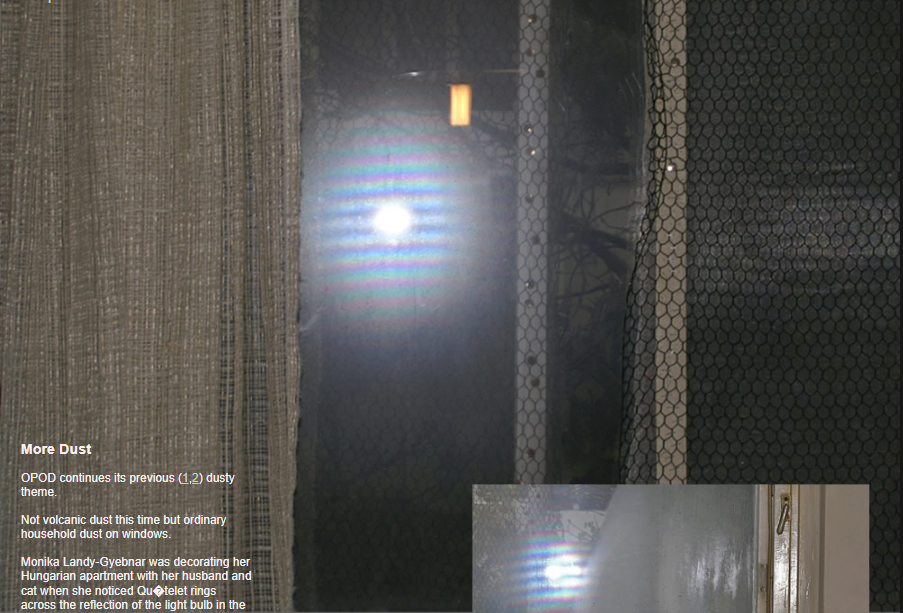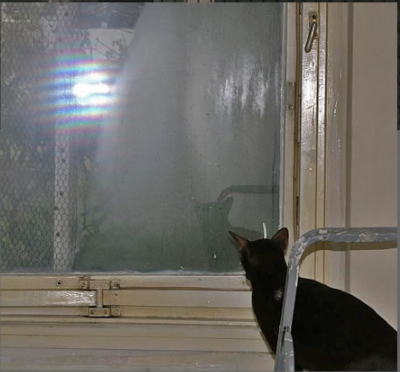More dust, but not volcanic
More Dust, but Not Volcanic: Exploring the Phenomenon of Quetelet Rings
Have you ever noticed peculiar multi-colored fringes on dusty windows or mirrors? Perhaps you've observed them on calm water surfaces laden with pollen, dust, or even algae. These mesmerizing fringes, known as Quetelet rings, are not caused by volcanic dust but rather by ordinary household dust particles that settle on or near reflective surfaces. In this article, we will delve deeper into the fascinating phenomenon of Quetelet rings and explore the science behind their formation.
Unveiling the Science behind Quetelet Rings
When light interacts with small micron-sized particles resting on or near a reflecting surface, such as dust on a window, it follows two distinct paths. Firstly, light can reach the particle directly, and secondly, it can be reflected from the surface before reaching the particle. As the incident light waves encounter the particle, they scatter predominantly forward, generating a series of outgoing spherical waves.
The two sets of outgoing waves then overlap and combine. In directions where the overlapping wavefronts align perfectly (in phase), they reinforce each other, resulting in the presence of light. However, in certain other directions, the waves are out of phase and cancel each other out. This interference condition is wavelength-dependent, giving rise to the vividly colored fringes observed in Quetelet rings.
A Closer Look at Quetelet Rings
To better understand the formation of Quetelet rings, let's take a closer look at their characteristics and where they can be observed:
- Appearance: Quetelet rings manifest as concentric circles or fringes surrounding a bright light source or reflection.
- Coloration: The colors observed in Quetelet rings vary depending on the wavelength of light involved in the interference. This gives rise to a spectrum of hues ranging from blues and greens to yellows and reds.
- Locations: Quetelet rings can be observed on dusty windows, mirrors, and even outdoors on calm water surfaces laden with pollen, dust, or algae.
- Particle Size: The size of the particles responsible for the formation of Quetelet rings is typically in the micron range. These particles can be as small as one millionth of a meter in diameter.
Exploring the Origin of Quetelet Rings
Now that we have a basic understanding of how Quetelet rings form, let's explore the possible sources of the particles that contribute to their creation:
- Household Dust: Ordinary household dust, composed of various particles like skin cells, fibers, pollen, and other debris, can settle on windows and mirrors, providing the necessary material for Quetelet rings to appear.
- Outdoor Elements: Outdoor environments can also contribute to the presence of particles that generate Quetelet rings. Pollen, dust, and even algae present in calm water surfaces can all play a role in the formation of these colorful fringes.
The Intriguing World of Atmospheric Optics
Atmospheric optics encompasses a wide range of captivating phenomena, including Quetelet rings. These optical effects offer us glimpses into the intricate interactions between light and the particles present in our environment. By studying and appreciating these natural wonders, we gain a deeper understanding of the physics behind them and the beauty they bring to our everyday lives.
Captivating Images of Quetelet Rings
To provide a visual representation of Quetelet rings, we showcase images captured by Monika Landy-Gyebnar. Her photographs beautifully illustrate the vibrant fringes and concentric circles formed by these optical phenomena. With her permission, we present her captivating images, showcasing the enchanting world of Quetelet rings.
In conclusion, although Quetelet rings may resemble the effects of volcanic dust at first glance, they are actually the result of ordinary household dust particles resting on or near reflective surfaces. These particles scatter and interfere with light, creating the stunning concentric fringes and circles we observe. By appreciating the science and beauty behind Quetelet rings, we gain a deeper appreciation for the intricate interactions between light and matter in our atmosphere. So, the next time you come across these mesmerizing optical phenomena, take a moment to marvel at the wonders of atmospheric optics unfolding before your eyes.

More Dust
OPOD continues its previous (1,2) dusty theme.
Not volcanic dust this time but ordinary household dust on windows.
Monika Landy-Gyebnar was decorating her Hungarian apartment with her husband and cat when she noticed Qu�telet rings across the reflection of the light bulb in the double glazed window.
The cat is curious about them. His name is Shaman and I�m told that he is an avid optics fan. The wire netting stops him jumping out of the window to search for circumscribed halos.
The multi-coloured fringes, �Qu�telet rings� can be seen on dusty windows and mirrors and outdoors on calm water surfaces laden with pollen, dust and even algae.
They are generated when small micron-sized particles rest on or are close to a reflecting surface.
Light reaches the particle along two routes (1) directly and (2) after being first reflected from the surface. The particle scatters the incident light waves predominantly forwards into a series of outgoing spherical waves.
The two sets of outgoing waves overlap and combine. In directions where the overlapping wavefronts have the same amplitude direction (in phase) they reinforce and there is light. In some other directions the waves are out of phase and they cancel each other out.
The cancellation or interference condition is wavelength dependent and so the resultant fringes are coloured.
Images ©Monika Landy-Gyebnar, shown with permission.


Note: this article has been automatically converted from the old site and may not appear as intended. You can find the original article here.
Reference Atmospheric Optics
If you use any of the definitions, information, or data presented on Atmospheric Optics, please copy the link or reference below to properly credit us as the reference source. Thank you!
-
<a href="https://atoptics.co.uk/blog/more-dust-but-not-volcanic/">More dust, but not volcanic</a>
-
"More dust, but not volcanic". Atmospheric Optics. Accessed on November 25, 2024. https://atoptics.co.uk/blog/more-dust-but-not-volcanic/.
-
"More dust, but not volcanic". Atmospheric Optics, https://atoptics.co.uk/blog/more-dust-but-not-volcanic/. Accessed 25 November, 2024
-
More dust, but not volcanic. Atmospheric Optics. Retrieved from https://atoptics.co.uk/blog/more-dust-but-not-volcanic/.